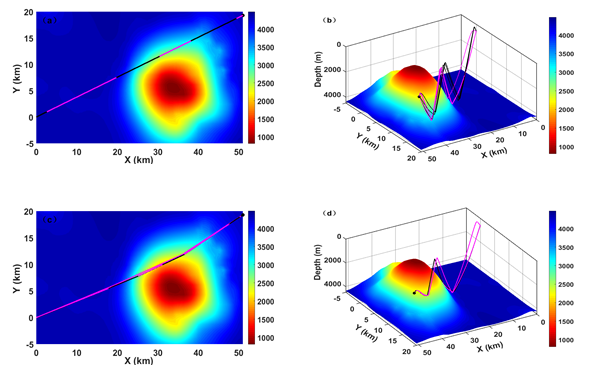In the deep water, acoustic waves may deviate from the original direction because of the interaction with seamounts, thus significantly affecting sound propagation. Previously, 2D models were usually used to investigate the effect of sound propagation under seamount environment in the deep water before, but 3D models are widely applied in recent years owing to the rapid development of ocean acoustics.
Recently, based on an experiment conducted in the South China Sea in 2016, researchers from the Institute of Acoustics (IOA) of the Chinese Academy of Sciences revealed the causes of the phenomena about horizontal refraction of acoustic waves in deep water with Ray methods (BELLHOP 3D model). The study was published online in Acta Physica Sinica.
The experimental and numerical results showed that the convergence zone structures were destroyed by the direct blockage of seamount due to the multiple reflection of acoustic waves, which led to the increase of transmission losses (TLs) and horizontal-refraction zone with obvious boundaries appears behind the seamount.
The experimental sound field structure behind the seamount is obviously different from BELLHOP N×2D model numerical results, due to the lack of considering the horizontal refraction effects. As a result, the N×2D model cannot explain some of the experimental phenomena.
After analyzing the differences between experimental data and numerical results from BELLHOP 3D model which contains the azimuth-coupling capability, researchers concluded that sound waves, after the interaction with seamount, reached the receiver through horizontal refraction when the source was located in the rear of seamount.
As a result of the horizontal refraction effects, some sound beams cannot reach the receiver, making the Eigen rays obtained from 3D model being less than N×2D model numerical results, while the experimental TLs becoming larger consequently.
Therefore, 3D effects of seamounts have obvious impacts on sound field within a certain angle range behind the seamount, and the investigation of 3D effects of seamounts is meaningful for the sound propagation and target detection in the deep water.
| 
|
| Figure 1. Numerical TLs calculated by BELLHOP model, where the source depth is 200m, the receiver depth is 525m, the central frequency is 300Hz.(a)The results of N×2D model (b), The results of 3D model, respectively. (Image by IOA) 
Figure 2. Comparison of numerical and experimental TLs behind the seamount within 45° to 122°. (Image by IOA) 
Figure 3. Numerical results of Eigen rays when the source located in strong horizontal refraction zone. (a) (b) Eigen rays calculated by N×2D model; (c) (d) Eigen rays calculated by 3D model, respectively.(Image by IOA) |
Funding for this research came from the National Natural Science Foundation of China (11434012, 41561144006 and 11874061).
Reference:
LI Shenghao, LI Zhenglin, LI Wen, QIN Jixing. Horizontal refraction effects of seamounts on sound propagation in deep water. Acta Physica Sinica, 2018, 67(22): 224302. doi:10.7498/aps.67.20181480.
Contact:
WANG Rongquan
Institute of Acoustics, Chinese Academy of Sciences, 100190 Beijing, China
E-mail: media@mail.ioa.ac.cn